Traditionally served on the Passover Seder plate, charoset is an apple and walnut salad made with sweet honey and red wine.

Passover is a Jewish springtime celebration of the exodus from Egypt, where they were freed from slavery. We metaphorically retell this story at the beginning of Passover with 6 different food items.

Items on the Passover Seder Plate
- Bitter herbs represent the hard times endured by the Jewish people during their slavery.
- Charoset, this recipe, represents the brick and mortar used by the Hebrew slaves to build Egyptian pyramids.
- Parsley, or another green vegetable, represents hope and renewal but is dipped in saltwater to represent tears.
- Roasted chicken neck or shankbone to represent the sacrificial lamb at the temple in Jerusalem.
- Roasted or hard-boiled egg is a symbol of mourning, traditionally served at funerals.
- Matzo is a flat, cracker-like bread that we eat during Passover. It serves as a reminder that the Hebrews fled Egypt so quickly, they could not wait for their bread to rise before leaving.

The story told at Passover Seder is one of sadness and triumph, and these symbolic foods are part of the ceremony that tells this liberation story of the Jewish people.

There are many variations of Charoset, an apple and walnut salad made with sweet honey and red wine. Often it is made with shredded apples and mixed into a paste that represents brick and mortar. However, my recipe uses chopped apples and walnuts instead for a crunchier texture that’s easier to enjoy.

How to make Charoset
Charoset is traditionally served on the Passover Seder plate, but you can serve it anytime! We’ll start first with chopped apples. You can choose any variety you like.

You can buy walnuts chopped already, but I like to chop them myself to get the consistency I prefer. Either way is fine. Some people also like to toast their walnuts first. If you do that, just 10 minutes at 325 degrees will do the trick.

Add in the sweet honey. You can feel free to adjust to taste depending on the apples you choose. For example, tart granny smith apples might require extra honey.

Of course I prefer using Manischewitz red wine for my Charoset, but if you can’t find it, a ruby port or sweet red will do just fine.

After mixing it all together, you can serve immediately or cool in the fridge overnight. Be sure to mix well again right before serving as the liquid often seeps to the bottom.

I will warn you – you won’t find two families that agree on all of these ingredients! Some friends like sugar, and others raisins. Many people prefer it chopped by hand, but some in a food processor. Still, others add figs or citrus zest or any number of secret family ingredients. To me, that’s the best part of a cultural family recipe: everyone’s got their own special version.

Frequently Asked Questions
What is Charoset?
What is a Passover Seder?
Do you eat the food on a Seder plate?
Does it matter what apples I choose?
What if I don’t have Manischewitz, can I use any red wine?
I’m not Jewish. Can I eat Charoset?
Do you have other Jewish recipes I can try?
Whether or not you’re Jewish, you can enjoy this apple and walnut salad any time of year. It’s crunchy and delicious.

Your Seder plate is waiting.

Charoset (Apple and Walnut Salad)
Ingredients
Instructions
- Place all ingredients in a large bowl and toss well. Let sit for at least 30 minutes before serving.















Leave a Reply